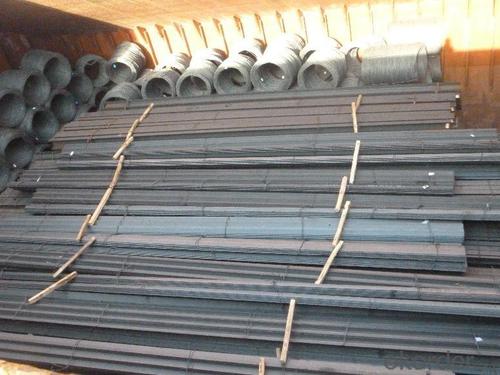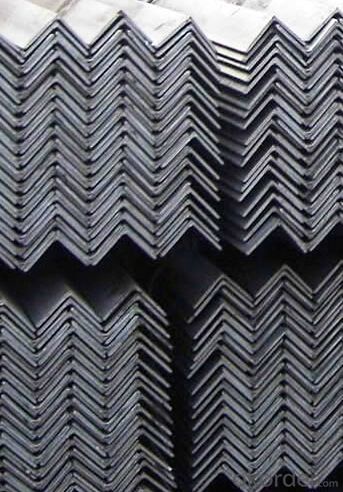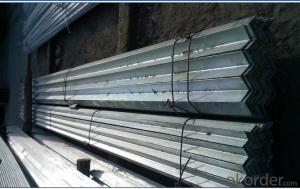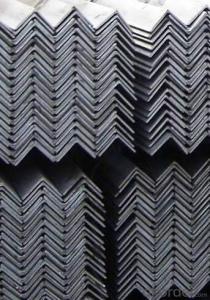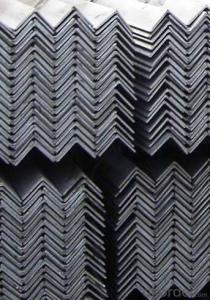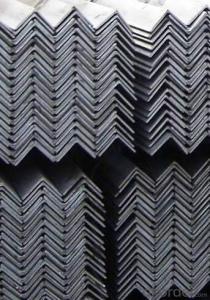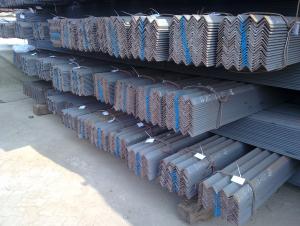ASTM STANDARD HIGH QUALITY HOT ROLLED ANGLE
- Loading Port:
- Tianjin
- Payment Terms:
- TT OR LC
- Min Order Qty:
- 50 m.t.
- Supply Capability:
- 100000 m.t./month
OKorder Service Pledge
OKorder Financial Service
You Might Also Like
Appearance: Black
Technique: Slitting hot rolled steel coil
Grade: Q235, Q195,A36 SS400 S235jr.St37-2
Standard: AISI,GB,DIN,ASTM,EN,JIS
Length: 6m, 9m, 12m or as your requirement.
Width: 10mm-1010mm
Thickness: 1.5mm-20mm
Business type: big manufacture
Place of origin: Tianjin China (Mainland)
Packaging Details: In bundles for exporting and sea worthy
Delivery Detail: Within 15-35 days after receiving L/C or deposite T/T

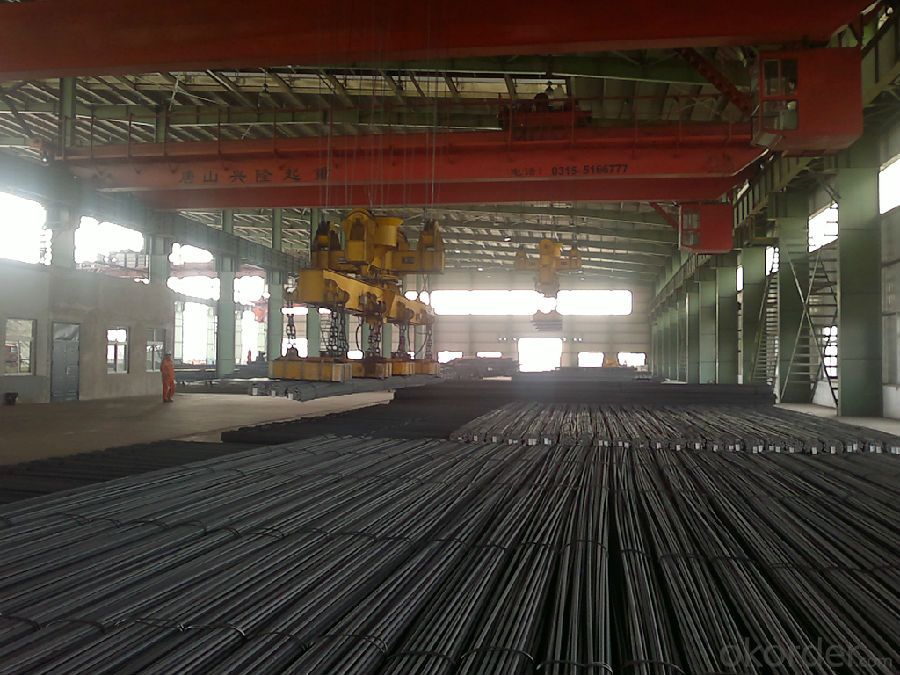
General specification as below:
Flat Bar Specification | |||
Width (mm) | Thickness (mm) | Length (m) | Theoretical Weight (kg/m) |
20 | 2.0 | 6/9/12 | 0.31 |
20 | 2.5 | 6/9/12 | 0.39 |
20 | 2.75 | 6/9/12 | 0.43 |
25 | 2.5 | 6/9/12 | 0.49 |
25 | 3.75 | 6/9/12 | 0.74 |
30 | 2.5 | 6/9/12 | 0.59 |
30 | 3.5 | 6/9/12 | 0.82 |
30 | 9.75 | 6/9/12 | 2.30 |
40 | 3.5 | 6/9/12 | 1.10 |
40 | 4.75 | 6/9/12 | 1.50 |
40 | 11.75 | 6/9/12 | 3.69 |
50 | 2.75 | 6/9/12 | 1.08 |
50 | 4.5 | 6/9/12 | 1.77 |
50 | 9.75 | 6/9/12 | 3.83 |
60 | 5.5 | 6/9/12 | 2.60 |
60 | 7.5 | 6/9/12 | 3.53 |
60 | 11.5 | 6/9/12 | 5.42 |
80 | 5.5 | 6/9/12 | 3.45 |
80 | 7.5 | 6/9/12 | 4.71 |
80 | 11.75 | 6/9/12 | 7.38 |
100 | 3.25 | 6/9/12 | 2.55 |
100 | 4.75 | 6/9/12 | 3.73 |
100 | 7.5 | 6/9/12 | 5.89 |
120 | 9.75 | 6/9/12 | 9.18 |
120 | 11.75 | 6/9/12 | 11.07 |
150 | 9.75 | 6/9/12 | 11.48 |
150 | 11.5 | 6/9/12 | 13.54 |
150 | 13.5 | 6/9/12 | 15.90 |
160 | 11.75 | 6/9/12 | 14.76 |
200 | 9.5 | 6/9/12 | 14.92 |
250 | 5.75 | 6/9/12 | 11.28 |
340 | 7.75 | 6/9/12 | 20.68 |
Products Advantages
1. high quality competitive price and Accurate in size
2. high dimensional accuracy
3. Guaranteed raw material
4.high utilization rate of material
5.convenient in construction, saving much time and labor
6. high mechanical strength
Application: Widely used for construction, Ship building, Machinery manufacturing ,steel structure,agriculture and steel grating.
- Q: Bearing capacity of angle steel and channel steel
- Angle called angle, the steel strip is perpendicular to each other on both sides into the corner. There are equal angles and unequal angles. The two sides of an equal angle steel are equal in width. The specifications are expressed in millimeters of edge width * edge width * edge thickness. Such as "/ 30 x 30 x 3", that is 30 mm width equal angle, edge thickness of 3 mm. Also available models that model is the number of centimeters wide, such as angle 3#. The model does not mean the size of the different edges and sizes of the same model. Therefore, the width, the edge and the thickness of the angle iron should be filled out in the contract and other documents, so as not to be indicated by the model alone. Standard Specification for hot-rolled equal angle iron is 2#-20#. The angle iron can be made up of different force components according to the different structure, and can also be used as the connecting piece between the components. Widely used in a variety of architectural and engineering structures, such as beams, bridges, towers, hoisting and conveying machinery, ships, industrial furnace, reaction tower, container frame and warehouse.Angle steel performance index: the performance test of angle iron is mainly tensile test and bending test. Indicators include yield point, tensile strength, elongation and bending compliance.
- Q: Can steel angles be used for manufacturing outdoor benches?
- Outdoor benches can indeed be manufactured using steel angles. These angles possess remarkable strength and durability, rendering them highly suitable for outdoor settings where benches may face harsh weather conditions. Moreover, it is effortless to weld steel angles together, allowing for the creation of a robust frame for the bench. This steel frame can then be combined with alternative materials like wood or metal slats to fashion the seating surface. In summary, steel angles are widely favored when it comes to manufacturing outdoor benches due to their exceptional strength, durability, and versatility.
- Q: Can steel angles be used for framing or supporting exterior façade elements?
- Yes, steel angles can be used for framing or supporting exterior façade elements. Steel angles provide structural support and stability, making them suitable for framing and supporting various components of an exterior façade, such as windows, doors, cladding, and signage. They offer strength, durability, and versatility, making them a popular choice in architectural and construction applications.
- Q: Can steel angles be used in agricultural buildings?
- Yes, steel angles can be used in agricultural buildings. Steel angles, also known as angle iron, are commonly used in construction due to their strength and versatility. In agricultural buildings, steel angles can be utilized for various purposes such as framing, bracing, and supporting the structure. They can be used to create sturdy frames for walls, roof trusses, and other structural elements. Steel angles also provide excellent load-bearing capacity, making them suitable for supporting heavy equipment or machinery commonly found in agricultural buildings. Moreover, steel angles are resistant to corrosion, which is essential in agricultural environments where exposure to moisture and various chemicals is common. Overall, steel angles are a practical and reliable choice for agricultural buildings due to their strength, durability, and resistance to environmental factors.
- Q: Are steel angles resistant to corrosion?
- Yes, steel angles are generally resistant to corrosion. Steel angles are commonly made from carbon steel or stainless steel, both of which have inherent corrosion-resistant properties. Carbon steel angles have a protective layer of iron oxide, known as rust, which forms on their surface when exposed to oxygen and moisture. This rust layer acts as a barrier, preventing further corrosion of the underlying metal. Stainless steel angles, on the other hand, contain a minimum of 10.5% chromium, which forms a thin, transparent oxide layer on the surface. This oxide layer, called a passive film, provides excellent corrosion resistance, making stainless steel angles highly resistant to rust and other forms of corrosion. However, it is important to note that steel angles can still corrode under certain conditions, such as prolonged exposure to high levels of moisture or corrosive chemicals. Regular maintenance and proper cleaning can help extend the lifespan of steel angles and enhance their corrosion resistance.
- Q: Can steel angles be used for manufacturing machinery?
- Indeed, the utilization of steel angles is viable for the production of machinery. In the construction sector, steel angles are frequently employed as structural elements owing to their robustness, resilience, and cost-effectiveness. In the realm of machinery manufacturing, steel angles find utility in a multitude of ways, encompassing framing, support structures, brackets, and mounting components. They bestow stability and rigidity upon the machinery, thereby ensuring its structural integrity. Moreover, steel angles facilitate the welding, bolting, or riveting processes with ease, permitting flexible and efficient fabrication techniques. By and large, steel angles represent a versatile and dependable choice for the manufacturing of machinery.
- Q: What are the common connection methods for steel angles?
- Depending on the specific application and structural requirements, steel angles have several common connection methods available. One commonly utilized method is welding. Steel angles can be joined together through various welding techniques, such as arc welding or MIG welding. This connection method ensures a robust and long-lasting bond between the angles. Bolting is another prevalent approach. By using bolts, nuts, and washers, steel angles can be securely connected. This method allows for easy disassembly and reassembly if necessary, making it ideal for situations where adjustments or replacements may be required in the future. For steel angles subjected to shear or tension forces, riveting is a reliable connection method. Rivets are employed to link the angles together, resulting in a strong and dependable connection. In certain cases, adhesive bonding can be used to connect steel angles. Specialized adhesives are employed to create a sturdy bond between the angles. This method is particularly useful when welding or bolting is not feasible or desired. When selecting the appropriate connection method for steel angles, it is important to consider factors such as load capacity, structural integrity, and the specific requirements of the project. Consulting with a structural engineer or a professional in the field is recommended to ensure the optimal connection method is chosen for a particular application.
- Q: What is the typical size range for steel angles?
- The typical size range for steel angles varies, but commonly, they range from 1/2 inch to 8 inches in width and thickness.
- Q: What are the design standards for steel angles?
- The design standards for steel angles depend on the specific application and industry requirements. However, there are some general design standards that are commonly followed in the construction and engineering fields. One important aspect is the dimensional and mechanical properties of the steel angles. These properties include the angle's size, thickness, length, and weight. The dimensions are typically specified in millimeters or inches, and the mechanical properties determine the angle's strength and load-bearing capacity. In terms of shape, steel angles are typically L-shaped with equal or unequal legs. The equal-legged angles have two legs of the same length, while unequal-legged angles have two legs of different lengths. The angle's shape and geometry play a crucial role in determining its structural integrity and stability. Another important consideration is the material specification for the steel angles. The material used for fabrication should meet certain standards, such as the American Society for Testing and Materials (ASTM) specifications, to ensure the required strength, ductility, and toughness. Commonly used materials for steel angles include carbon steel, stainless steel, and alloy steel. The design standards for steel angles also include guidelines for connection details. These details specify the method of connecting the angles to other structural members, such as beams, columns, or plates. The connection details ensure proper load transfer and structural stability, and they may involve welding, bolting, or other mechanical fastening methods. Additionally, design standards may include guidelines for the design of steel angle members subjected to specific loads, such as axial compression, bending, or shear. These guidelines provide formulas, charts, and design tables that allow engineers to calculate the required size and strength of the angle based on the applied loads and other factors. Overall, the design standards for steel angles ensure that these structural members meet specific requirements in terms of dimensions, material properties, shape, and connection details. These standards help ensure the safety, reliability, and performance of steel angles in various applications, ranging from building construction to industrial machinery.
- Q: Can steel angles be used for architectural detailing or ornamentation?
- Yes, steel angles can be used for architectural detailing or ornamentation. They are commonly used to add structural support, create unique design elements, and enhance the aesthetic appeal of buildings. Their versatility, strength, and durability make them suitable for various architectural applications.
Send your message to us
ASTM STANDARD HIGH QUALITY HOT ROLLED ANGLE
- Loading Port:
- Tianjin
- Payment Terms:
- TT OR LC
- Min Order Qty:
- 50 m.t.
- Supply Capability:
- 100000 m.t./month
OKorder Service Pledge
OKorder Financial Service
Similar products
Hot products
Hot Searches
Related keywords



